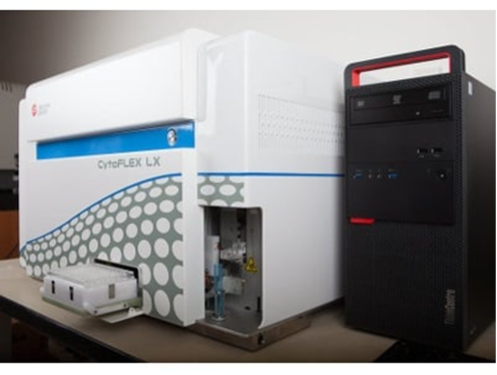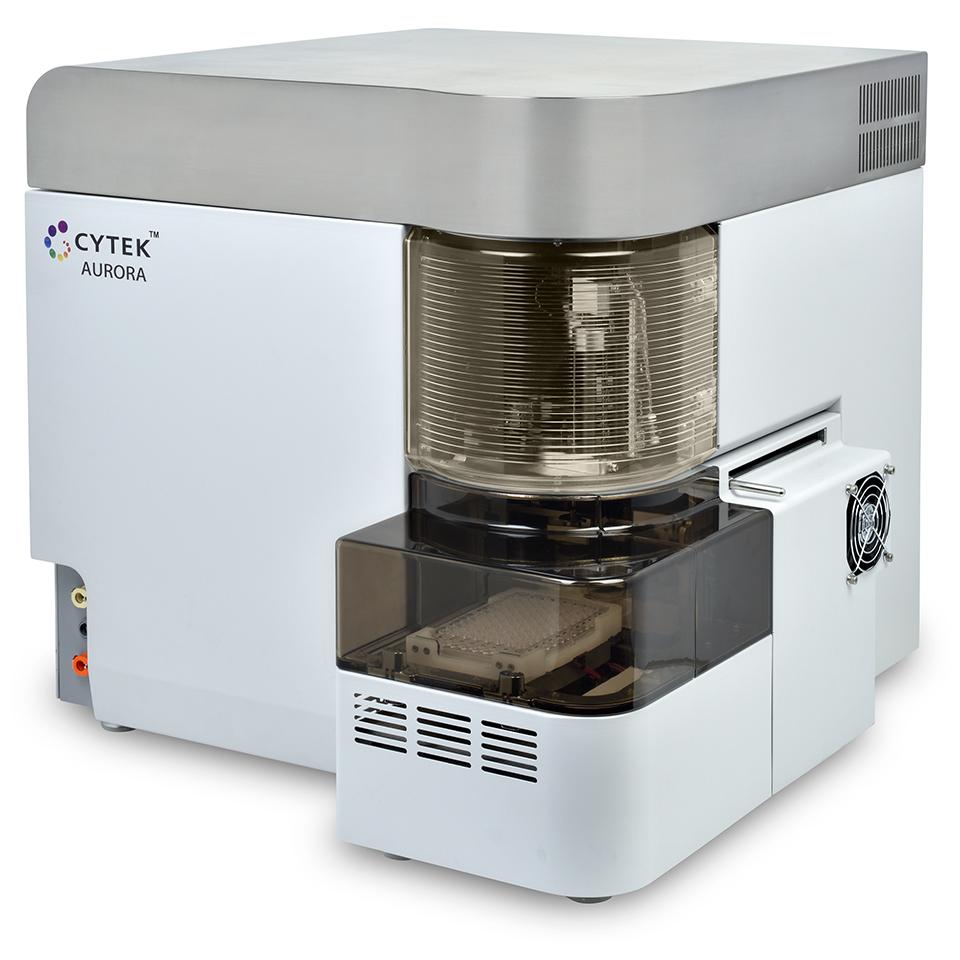Cytometry is the measurement of various physical and chemical properties of cells.
Flow cytometry is the process of making these measurements by suspending the cells in a fluidic stream passing by a light source (excitation) and detectors (emission).
Analytical Cytometry utilizes flow cytometers to collect data on cells that may, or may not, be stained by any number of antibody-coupled fluorochromes.
Learn more about the Hillman Cytometry Facility’s instrumentation for analysis of cells in suspension, or view our collection of facility-approved protocols and technical documents.
General User Guidelines
- Users must sign up for cytometer time in advance. Cancellations must be made by noon on the day before the scheduled time (this can be done by phone). Your account will be charged for the full time of a missed appointment.
- If you sign up for a time slot, please be on time.
- Please finish on time. Users must yield the cytometer to the next scheduled user. Allow time to clean the instrument before the end of your appointment.
- User training is offered for all of the facility’s analytic cytometers. Individuals are encouraged to learn how to best prepare and then acquire their own experiments.
- Basic users are limited to cytometer operation between the hours of 9 a.m. and 5 p.m., Monday through Friday. For individuals who wish to utilize the facility’s instrumentation after hours or on weekends, additional training is available to instruct users how to start-up, verify and shut down instruments. “Power Users” designated by the facility may sign up to use the cytometer after hours and on holidays and weekends. Basic users can use the cytometer after hours only if supervised by a “Power User.”
- Please keep the work area clean.
- The facility reserves the right to revoke privileges from individuals who consistently disregard these policies.
- The recommended sample volume is no less than 0.3 ml.
- Samples should be resuspended in 12 X 75 mm Falcon 5 ml tubes (Falcon # 352002 and 352063). Slightly undersized tubes will damage the sample head. If you think your tube may not fit properly, please ask us for the tubes to transfer your sample.
- Samples should be fixed in 0.5–2% paraformaldehyde or methanol-free formaldehyde to kill infectious material. Do not use common laboratory grade formaldehyde. Infectious material should be fixed in paraformaldehyde for at least 30 minutes for best results. If cells cannot be fixed, please make prior arrangements with the facility.
- No unfixed infectious material (including viruses used for transduction) or radioactive material is allowed in the laboratory.
- Filter cells: filtering of all samples is highly recommended. Cell preparations that are sticky or clumping must be filtered using a nylon mesh (Falcon 5 ml Polystyrene Round Bottom Tube with Cell-Strainer Cap 12x75mm; Part # 352235) or 1cc Tuberculin syringes. Anything less than 70 microns should flow through the cytometers. However, this assumes a single cell suspension. Cells that grow in monolayers, as well as large populations of dead cells or debris, will cause samples to clump, resulting in blocked cytometers and requiring cleaning to remove the block. This will result in often significant delays for yours and other users experiments.
Instrumentation
Becton Dickinson LSR Fortessa I
 The Fortessa I is a four laser flow cytometer capable of detecting up to 15 distinct fluorochromes simultaneously. Along with traditional forward and side scatter, the Fortessa I is equipped with a PMT dedicated to detection of forward scatter, making the Fortessa I ideal for microparticle detection. The Fortessa I is compatible with the High Throughput Sampler (HTS) attachment, allowing for reading samples directly from 96-well plates.
The Fortessa I is a four laser flow cytometer capable of detecting up to 15 distinct fluorochromes simultaneously. Along with traditional forward and side scatter, the Fortessa I is equipped with a PMT dedicated to detection of forward scatter, making the Fortessa I ideal for microparticle detection. The Fortessa I is compatible with the High Throughput Sampler (HTS) attachment, allowing for reading samples directly from 96-well plates.
View fluorochromes for the Fortessa I
Design panels for the Fortessa with FluoroFinder
More information about the Fortessa I
Becton Dickinson LSR Fortessa II
 The Fortessa II is a five laser flow cytometer capable of detecting up to 17 distinct fluorochromes simultaneously. The UV laser allows for the detection of three exceptional flurochromes. The Fortessa II is compatible with the High Throughput Sampler (HTS) attachment allowing for reading samples directly from 96 well plates.
The Fortessa II is a five laser flow cytometer capable of detecting up to 17 distinct fluorochromes simultaneously. The UV laser allows for the detection of three exceptional flurochromes. The Fortessa II is compatible with the High Throughput Sampler (HTS) attachment allowing for reading samples directly from 96 well plates.
View fluorochromes for the Fortessa II
Design panels for the Fortessa with FluoroFinder
More information about the Fortessa II
Becton
Coulter CytoFlex
 The CF operates three Beckman Coulter Cytoflex that present with different configurations. There is a two-laser, a four-laser and a six-laser cytometer available for a variety of applications. The two-laser and four-laser models are great for simple experiments such as cell cycle, apoptosis detection and single fluorophore detection. The four-laser and six-laser models are useful for more complex multi-parameter panels. The four and six laser models are equipped with a 96-well plate reader.
The CF operates three Beckman Coulter Cytoflex that present with different configurations. There is a two-laser, a four-laser and a six-laser cytometer available for a variety of applications. The two-laser and four-laser models are great for simple experiments such as cell cycle, apoptosis detection and single fluorophore detection. The four-laser and six-laser models are useful for more complex multi-parameter panels. The four and six laser models are equipped with a 96-well plate reader.
Currently, the two and six-laser models are located in the UPMC Hillman Cancer Center Research Pavillion. The four-laser model is located in the Assembly.
Beckman Coulter has many resources available. You can download the analytical software without charge thru their website.
Fluorescence Spectrum Analyzer
Cytek Aurora
 The Cytek Aurora is a 5-laser, high-parameter spectral cytometer capable of detecting up to 30 distinct fluorochromes simultaneously. Using an array of 64 detectors, the Aurora examines the entire emission spectra of fluorochromes and uses linear unmixing to investigate the individual parameters. This allows for the combination of highly similar dyes with overlapping emission peaks that would be otherwise indistinguishable on a conventional cytometer. Equipped with 5-lasers (355, 405, 488, 561, and 640nm), the Aurora can be used with most commercially available fluorochromes. It also features a 96-well plate sampler, allowing for easier workflow and automated sample acquisition.
The Cytek Aurora is a 5-laser, high-parameter spectral cytometer capable of detecting up to 30 distinct fluorochromes simultaneously. Using an array of 64 detectors, the Aurora examines the entire emission spectra of fluorochromes and uses linear unmixing to investigate the individual parameters. This allows for the combination of highly similar dyes with overlapping emission peaks that would be otherwise indistinguishable on a conventional cytometer. Equipped with 5-lasers (355, 405, 488, 561, and 640nm), the Aurora can be used with most commercially available fluorochromes. It also features a 96-well plate sampler, allowing for easier workflow and automated sample acquisition.
Prior-experience with flow cytometry and specialized training are required to use this advanced cytometer; please contact the facility staff to arrange. Staff are also available to assist in panel design and experiment consultation.


